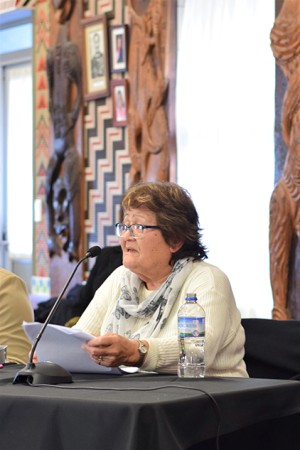What witnesses said about Io narratives
- “I agree with those who question whether Io / God is not a recent addition that is out of sync with the plurality of Atua; or the way male Atua have been given a new storyline that shrinks that of the female Atua.” (Donna Awatere-Huata, doc A20, p 3)(external link)
- “The primordial creator Io, who / which exists beyond Rangi and Papa, is the ultimate creator. Io has been translated as ‘The Supreme Being’, and the ‘Unknown Creator’. By and large, Io has been translated in the literature as a male entity, though on closer scrutiny all other aspects of Māori mythology embody a duality of divinities, the male and the female. Though there is little evidence to corroborate the existence of a central, or Supreme Being called Io across all tribes, Rose Pere provides a deeper meaning of the word Io, which addresses the ‘duality’ anomaly. According to Pere, A-I-O is the supreme life force, the godhead, comprising the combined sound vibrations of the mother – A; the child – I, and the father – O; together these sound vibrations form the basis of all life. On Pere’s interpretation, it is the sounds, as represented in karakia, kāranga, and other ritual chants, that evoke, celebrate, and acknowledge, the power and force of life, creation, and procreation. Thus, female and male energy combine and represent the duality which is mirrored in the duotheism of earth mother and sky father, of Papatuānuku and Ranginui. On that basis, the word AO, glossed as ‘world’, also takes on new meaning, as it is the duality of male and female, without the child. It is the addition of the sound I which represents procreation and everlasting life through the child.” (Ella Henry, doc A63, p 6)(external link)
- “[Elsdon] Best also emphasises the existence of a singular supreme being and within his writings that being is clearly defined as male, in line with western Christian beliefs in a singular male God. Best finds the notion of a Supreme Being as a ‘remarkable achievement’, clearly because he is able to locate such a notion in line with his own beliefs in a patriarchal driven religion.” (Leonie Pihama, doc A19, p 30)(external link)
- “Whakapapa begins in the pre-mortal life of Io which is the origin of the whakapapa of mana.” (Genevieve Ruwhiu Pupuke, doc A102, p 5)(external link)
- “Whakapapa starting with Io-matua or Io-matua-kore was confirmed at a hui of Raukawa kaumatua at Kihikihi in 1912, which was fully recorded and documented by secretary, Raureti Te Huia of Ngāti Maniapoto. Nine kaumatua of various related iwi attended this hui including Te Whiwhi Mokau of Ngāti Maniapoto (chairman) and Te Kaponga Tekowheto of Ngāti Raukawa. At that hui, it was stated that the concept of Io-matua was part of the cultural and religious heritage brought here on the Tainui waka. At least one Ngāti Raukawa tohunga of the Io religion never became Christian – Te Aokatoa of Ngāti Takihiku, who had travelled with Te Whatanui to Ahuriri in the attempt to settle there, and then returned to Wharepuhunga in the Waikato. Te Aokatoa is said to have had immense spiritual powers. For example, he once deflected a curse by karakia, with fatal consequences. Te Aokatoa and Tiwai Paraone of Hauraki, also a high priest of the Io religion, designed Te Paki o Matariki, the Coat of Arms for the Kingitanga, which included the sacred symbols.” (Heeni Collins, doc A108, p 5)(external link)
- “All the names of Io can be seen as gender-neutral. These are taken from Te Rangihiroa, Sir Peter Buck, The Coming of the Maori (1949): Io-matua – Io-parent of all things; Io-matua-kore – Io-parentless; Io-te-pukenga – Io-the source of thought, knowledge and reflection; Io-te-wānanga – Io-the source of all knowledge; Io-mata-ngaro – Io-of the hidden face; Io-te-waiora – Io-the source and giver of life. One of Raukawa’s grandsons, a son of Rereahu, was named Te Io-wānanga.” (Heeni Collins, doc A108, p 6)(external link)
- “E tatou ma, waahine, taane, this is what I know of the cosmos and the creation of our Ao, te Ao o hapu, te Ao o Iwi. And from the Ngapuhi Waananga, Io-Matua-Kore, a Io-Taketake, ara, Io-Waananga seeded te Kore and Te Kowhao laying down the foundation of all things in the beginning, the taatai of events, and mauri that was infused into the cosmic process at various stages of growth to begin the quest to fulfil the latent urge and potential towards being and self-realisation. From Ngapuhi accounts, potential and urge, the energy that was already in existence in Te Kore with Io Taketake, just needed a bit of a korikori to get movement into the cosmic process, which continues to evolve, mai i te kore, ki te po ki te ao maarama. Maori Marsden did state that Io communed with himself, why did he do that, it was to activate both the male and female elements. I think this is a critical piece of information that we should not leave out of our narrative. Our ability to co-create not just to be known as te whare tangata.” (Ipu Tito-Absolum, doc A70, p 4)(external link)

Ipu Tito-Absolum giving evidence at Terenga Parāoa Marae, Whangārei